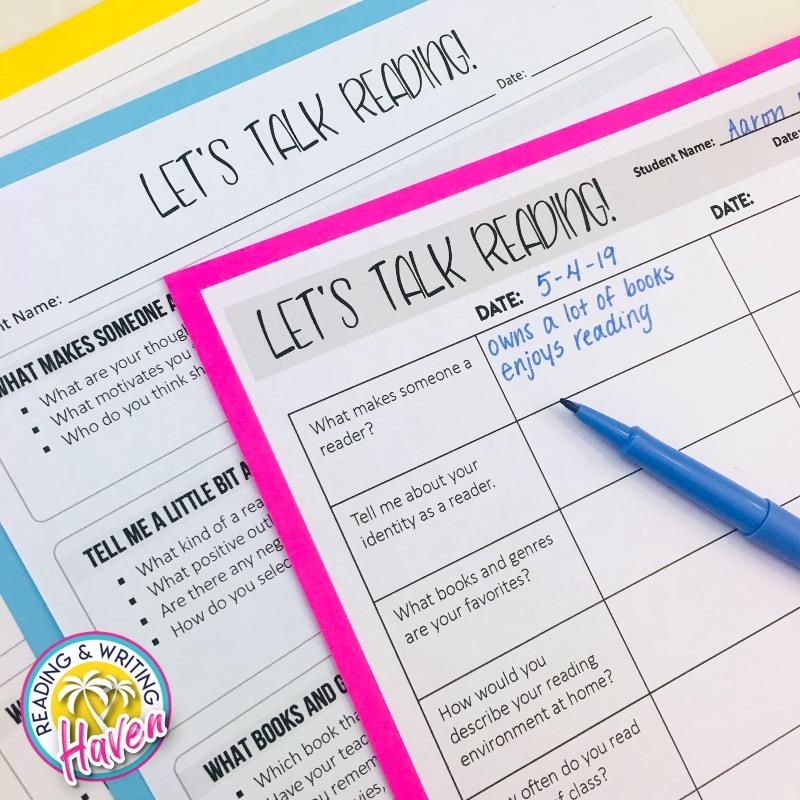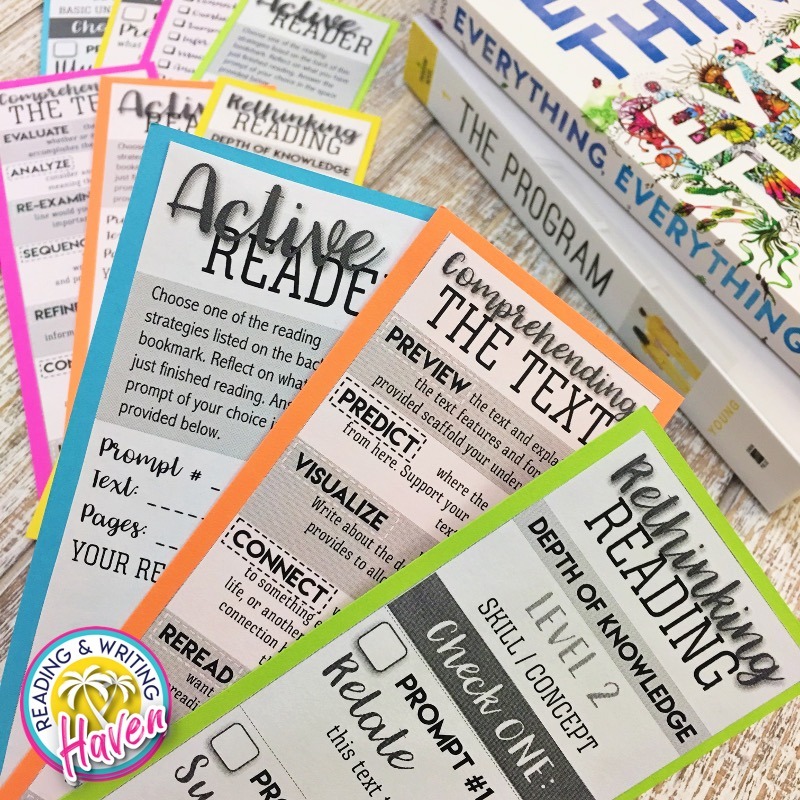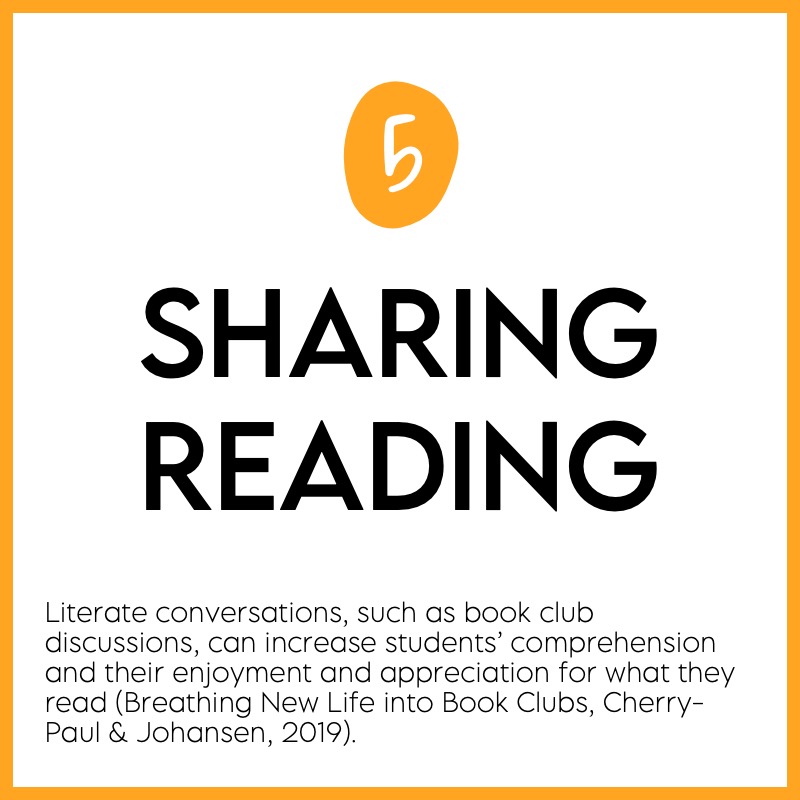6 Reading Routines Every Classroom Needs!
It’s happened to me frequently. I sit down, head swirling with ideas, clear about the direction I want to go with my instructional sequence. And then…as soon as I try to put it into words in my planbook, the clarity disappears. Frustrating. Has this happened to you? Teaching middle and high school ELA is a peculiar situation. Often, we have 45 minutes to “make it count,” “meet all the standards,” and pretty much just “do all the things.”
Routines have saved my sanity. Often, we think about routines in terms of classroom management, but we can use routines with every aspect of English Language Arts. In this post, you’ll find my best ideas for how to make reading come alive in the middle and high school classroom. These reading routines add an element of predictability and organization but have enough flexibility that nothing feels mundane. Because boredom is the worst.
So, what are these routines? I’ll preface them by saying they aren’t magical. You don’t have to earn a degree from Hogwarts to appreciate them. And, they aren’t the only routines you can use. But, these reading routines ARE special in that they are foundational, time-saving, and effective for helping to address both standards and readers.
For each routine, you’ll see a How often? question. This is where you can find my recommendation for how often to incorporate that routine. You may find your own students need a different frequency.
So, let’s look at them!
ESSENTIAL READING ROUTINES
1. Daily Reading
You may be approaching this post from a standpoint where you’ve already established a choice reading frequency in your classroom. Great! Or, you may be reading looking for just this very thing…how frequently should students be given time to read what they want…and at what cost?
It saddens me when I hear teachers say they are prevented from incorporating independent reading on a regular basis. Allowing students to read what they want is essential for growth, for perspective, and for interest.
If you haven’t already established a daily independent reading routine in your classroom, it’s not too late. When I began incorporating the simple routine of beginning every day with choice reading, I noticed community grow, readership increase, and book discussions flourish. Plus, daily independent reading builds reading stamina that helps students persevere through complex texts.
Perhaps your classroom structure doesn’t allow for daily independent reading. I do prefer the daily structure because it creates a habit, but if it’s not possible, how often can you fit it in? Do that!
When establishing your reading routine, make sure to define when it will happen. This predictability helps students to be prepared. Should they come to class, sit down, and immediately open their book? Will they be allowed to decompress at the end? Beginning the class period has always been more effective for me because I’m less likely to skip it!
How often? As mentioned above, daily reading is helpful for promoting a habit and drawing students into their books. Daily choice reading time is often effective as a bell ringer, but there are other possibilities as well. If you can make it work, it’s worth the investment.
2. Reading Conferences
I’ve grown as a reading teacher over the years. I used to sit and read, silently modeling reading for my students. While I don’t think there’s anything wrong with that approach and still find it valuable, I now believe silent reading time is more productive with conferences.
Creating a routine of conferencing with students about their books means that we are prioritizing getting to know our readers. What do they like? What skills are their strengths, and what are their areas for growth?

As a middle or high school teacher, conferences can be challenging to manage with a short time table. You may only see your students one time per month if you use a ten minute daily reading time to chat. While not ideal, that’s better than not at all! And, if you have groups of students who are working on the same reading strategies, you can quietly work with them in small group format to maximize the time.
How often? Reading conferences are best in a daily format. A goal would be while students are reading their books, make time to speak with two students about what they are reading. You may choose to do one day a week of read aloud or modeling reading silently instead of conferring every day. And, that’s okay! Do what works for your classroom.
3. Identity Awareness
Those of us who are steeped in research about choice reading are well-versed in its benefits. With all forms of reading – whole class, small group, and independent, we have opportunities to collect data to help us teach our readers and justify independent reading time. Research shows that the amount of time students spend reading correlates to their reading achievement.
One way we can quantify the impact of reading is to look at data about a reader’s identity and habits. Students can and should help us to collect that data as a part of their metacognitive process. When students know why they should read, reflect on their habits as readers, and set goals for the future, they have ownership in the journey.
Book Fit
Specifically, one reading routine we can incorporate is book fit. Students need to know how to select books that are “just right” for them. This is not the same as leveling. Understanding book fit means students are adept at approaching a collection of books and understanding themselves as readers well enough to know if they want to try a book.
Especially when students get older, if they recognize a book is at their frustration level, they will know they should ask for help and that it will take additional time. Book fit is a routine I teach at the beginning of the year, but once students are comfortable with it, they can use this routine every time they pick out a book. I find that using a ladder visual is especially helpful.
Book Volume
It can boost student confidence and build class momentum to track reading volume. I don’t love reading logs and actually find they can have a negative impact on students’ experience with reading. That’s not what I’m talking about here.
To make this reading routine valuable, I’ve adopted a couple different approaches. For one, students can use the same reading ladder metaphor they use to record book fit to assess total reading volume. Each time a student finishes or abandons a book, they can record the title on their bookshelf. (I have both a print and digital version to accommodate for different learning settings.)
Keeping track of whole class reading volume becomes more challenging to manage. One routine I’ve enjoyed is having students add to a physical bookshelf. As they finish a book, they can add spines to the wall. Throughout the year, it’s fun to see the display grow!
Book Diet
A third way to help students collect data to shape their reading identities is to do a book diet audit. I use the same reading ladder and ask students to color code their books into groups. For instance, what literary genres have they read? Students may find they have diversified themselves well, or they may find they are reading books from primarily one genre group. Students can also use this same auditing process to reflect on diversity in the books they are reading.
How often? I’ve found the book spines and reading ladder are best updated one time per week. During learning stations or any form of independent work, students can take a minute to update their personal reading ladders and add a book spine to the wall for any books they finished that week.
4. Strategy Practice
Even older readers benefit from practical reading strategies that can help them delve further into analysis and comprehension. As a reading routine, I often spend some time during each literature and informational text unit introducing and modeling strategies students can use when reading any text. Consider this example…
With literature, we talk about determining a theme and analyzing its development over the course of a text. In order to do so, we use a strategy called What? But? & So what?
- What? – This is usually a one word topic.
- But? – This would be an opportunity for students to present a contradiction that includes the conflict of the story.
- So what? – Here, students turn that juxtaposition into a statement that offers a universal truth about life.
I’ll use “The Interlopers” to illustrate.
- What? – a long-standing hatred between families
- But? – Ulrich and Georg could be friends, but instead they are selfishly fighting about land.
- So what? – Hatred may lead to destruction.
After introducing the strategy to students in the form of a whole class think aloud, I find certain formative assessments to be effective reading routines for students to use to practice them. Graphic organizers, bookmarks, exit slips, discussion cards, and annotations are just a few that benefit student learning.
Teaching students about specific reading strategies gives them the tools they need to crack open texts and think on a deeper level when reading independently.
How often? Truly, the frequency depends on your instructional sequence. In my situation, I find myself introducing a new reading skill and corresponding strategy about one time per week during reading standard units. On a daily basis, we can then remind and encourage students to practice these strategies while they are reading independently or in small groups.
5. Sharing Reading
Sharing reading is one of the cornerstones of a positive reading culture. It’s essential to build in reading routines that allow us to talk about books! What are we reading? What have we just finished? Are there books we would recommend? What about excerpts that students want to share because they’re just so good they leave you with goosebumps?
When I first started making time to talk about books in the classroom, I added in impromptu book talks after each ten-minute session of daily reading. I’d ask student who wanted to share about their book, or I’d offer something amazing (usually with a teaching tip or strategy reminder) from my own books.
After I began collaborating with my librarian, she started showing students book trailers to grab their attention. Once a month to kick off a new literary genre for our classroom bookclubs, she would come in and share both book talks and book trailer videos. Students really seemed to appreciate the variety. Then, some chose to make their own book trailers to share with classmates.
As time went on, I began incorporating discussion days one time per month where students could share what they are reading in an authentic book club fashion. We’d have snacks, thought-provoking questions, instrumental background music, and lots of laughter.
Students can also share what they are reading through a book recommendation format, like a class bulletin board or a digital reference slide.
How often? Sharing reading is beneficial as often as possible. However, having a specific time dedicated to sharing what we are reading will ensure it happens. Does it work for you to build in three minute impromptu book talks? Can you provide one day per month for book discussions? Do you regularly schedule learning stations where students would have an opportunity to share in small groups? Could students use bell ringer time once per week to contribute to a class recommendation board?
6. Write about Reading
Writing about reading is a routine that helps students to see how writers are readers and readers are writers. Truly, reading from a writer’s perspective adds another layer of depth to our analysis. And, writing with a reader in mind enhances our purpose and craft.

During and following every reading unit, I like to give students the opportunity to write about what they’ve read. Whether they are emulating a style, responding to the ideas, or analyzing the structure, students can write about reading in short or long formats.
Here are some specific ideas for pairing writing with different types of literature and nonfiction texts in the middle and high school classroom. I’d also add reader’s notebooks, sketchnotes, blogging, RAFTS, and reading sprints to that list!
How often? In an ideal world, students would read and write every day! If your world, like mine, is not ideal, I recommend developing a pattern. Read something and then write about it. Choose several of your favorite response to reading activities, and build them into your instruction at predictable times. For instance, maybe students get used to taking sketchnotes or annotating as they read and prepare for class discussions. Perhaps on Fridays, they practice extended reading sprints. Making writing about reading fit into a box is nearly impossible since life doesn’t always go as planned. But, being intentional about building written responses into our lesson plans will help.
I hope these reading routines have given you lesson planning clarity. Routines have helped me to approach my lessons with intentionality and organization, avoiding some of the frustrations that come with “Where do I start?” While they aren’t the only routines you may use, they go a long way toward building an inspiring reading culture in the secondary classroom.
Developing regular reading routines can foster confidence, relationships, and community. If you’re ready to get started in your own classroom, don’t forget to grab this free resource. It’s full of reflective questions, time-saving resource recommendations, and specific answers to frequently asked questions about teaching reading in middle and high school. Click here to get started!
FURTHER PROFESSIONAL READING:
If you’re looking for further reading and research on these foundational reading routines, I’ve included a list of many credible sources you can explore. To be transparent, the books are affiliate links. This means that if you purchase through the links below, I will receive a small commission at no extra cost to you.
- Writers are Readers
- The Book Whisper
- NCTE’s Statement on Independent Reading
- Reading Strategies
- Reading Conferences: Grades K-8
- Breathing New Life into Book Clubs
- Deeper Reading











